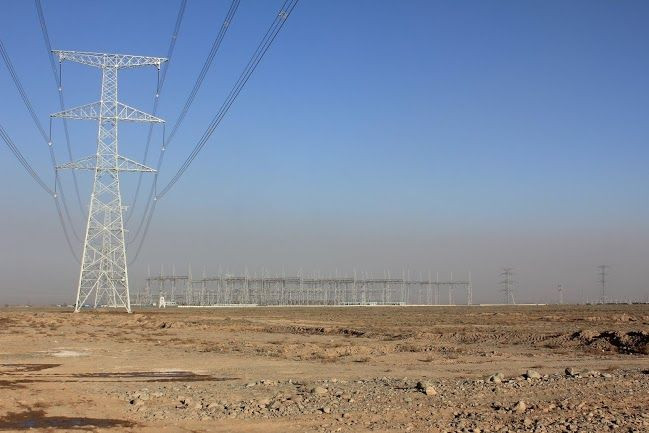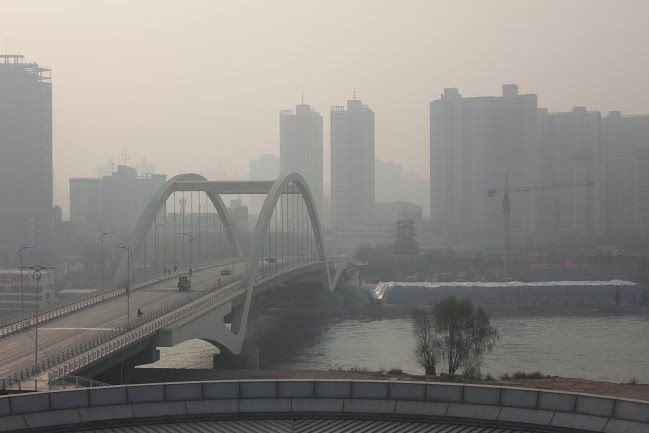Wind Farms, Solar Panels And Killer Smog: Coal Still Reigns In China's Schizophrenic Energy Revolution

JIUQUAN, China – By almost any measure, China’s Hexi Corridor seems an unlikely place to show off the country’s environmentally friendly, renewable energy.
A narrow, windy, 600-mile-long passage running along the southern border of the Gobi Desert in China's northwestern Gansu province, the corridor is rife with heavy industry and coal-fired power plants that rise like monoliths from the arid, dusty steppe. Howling winds from the desert carry heavy loads of smog from smokestacks that blur the edges of distant mountains and shroud the skies over urban areas.
Of all the cities of Jiuquan prefecture, Yumen is near the epicentre of this grim industrial landscape. Once a booming oil town, with some 20,000 people, the city's fortunes have declined as the oil has been depleted; thousands of people have moved on, and parts of the city now resemble a ghost town interspersed with a few petroleum refineries and coal-fired power plants that spew a toxic mix of emissions.
Yet it is here that China has chosen to make its greatest investment in renewable energy, for better or worse.
Solar panels glitter on the rooftops of buildings surrounding coal-fired power plants while hundreds of wind turbines spin in the strong, frigid winter winds blowing from the desert. An enormous 20-gigawatt (GW) wind power development is under construction that will be among the world's largest and – theoretically – will be part of China’s program to replace toxic coal-fired plants with environmentally friendly, sustainable power sources.

There is just one problem: The Hexi Corridor’s boom in solar and wind power is more conspicuous than effective. The odd juxtaposition of state-of-the-art renewable energy developments next to coal-fired dinosaurs is evidence of China’s schizophrenic energy policy, which emphasizes renewable energy even as it remains the world's biggest emitter of CO2 -- the primary culprit among greenhouse gases -- and to export its smog into neighboring countries and far over the Pacific Ocean.
“Where one coal power plant stops, another begins,” as James West, senior producer at climate change content platform Climate Desk, puts it.
If not for the scale of environmental damage that continues to be caused by the corridor’s heavy industry and coal-fired plants, the breadth of China’s commitment to renewable energy sources would, in fact, make the region a global model. In Jiuquan prefecture alone, primarily state-owned companies have developed wind and solar farms totaling 6GW and 1GW of installed capacity, respectively, during the past 10 years. And the dozens of wind-turbine blades piled up behind the gates of Jiuquan's new renewable-energy industrial park suggests that the local wind-power boom is far from over.
“Our goal is to reach 15GW of installed wind-power capacity in 2015 and add another 25GW by 2025, so that total capacity is going to reach 40GW,” Wu Xuesheng, head of the energy bureau of the Jiuquan Municipal Development and Reform Committee, said. That's enough power to run all of New York City, or to replace 10 coal-fired power plants and perhaps claim a spot in the world's top three wind-power energy producers. And Jiuquan is only the most obvious example of China’s renewable energy investment; similar developments are under construction all over the country.
Facing worsening levels of environmental contamination, Chinese authorities have pursued on an unprecedented scale the development of power generation from sources other than fossil fuels, including wind, solar, hydropower and, to a lesser extent, nuclear power, for two reasons: Those sources are more sustainable, and toxic pollution from coal plants has reached levels that even the aggressively pro-development government recognizes as dangerous. Smog has gotten so bad across China that pilots sometimes have difficulty landing planes because of limited visibility, and pollution masks have become one of the best-selling items in Chinese markets.
Already, China has installed enough wind turbines to power an entire nation the size of Mexico. No other country can compare in terms of investment.
Back in 2005, when a national legal framework for renewable energy developments was passed, China's share of global installed wind-power capacity was a meager 2.1 percent. Seven years later, in 2012, the country accounted for 27 percent of the world's wind power base with more than 75GW of installed capacity, followed by the U.S. (21 percent) and Germany (11 percent), according to figures from the Global Wind Energy Council (GWEC). Chinese manufacturers have taken over the wind-power industry worldwide, with four Chinese wind-turbine producers in the top 10 by market share. Guodian Corporation has overtaken Spain's Iberdrola SA (MCE:IBE) to become the world's largest owner of wind assets, according to figures from Bloomberg New Energy Finance.
An additional 70GW of new wind power is expected to come on-grid by 2015, alongside 120GW of large-scale hydropower and 5GW of solar power, according to the strategic goals included in the country's 12th Five-Year Plan, which covers the period from 2011 to 2015. Chinese authorities want non-fossil fuel generation to meet 11.4 percent of primary energy consumption by 2015, compared with 9.8 percent, according to figures from the National Energy Administration (NEA).
Such ambitions are already a matter of national pride, exemplified by huge propaganda efforts and photos of wind farms in Beijing's national history museum.
All Powered Up And Nowhere To Go
For now, though, it appears unlikely that China will be able to significantly reduce pollution by using renewable sources, for a variety of reasons, and so the passing of the daylight hours in cities such as Jiuquan’s provincial capital, Lanzhou, are marked by the changing hues of purple and brown smog. The primary reason the new energy sources are having limited impact is that the power grid necessary to distribute all the new, green power has not kept pace with the development of renewable energy sources.
“We built too many wind and solar farms over the last few years and, today, the transmission lines are full,” Li Shimin, deputy managing director of Lanzhou's UNIDO International Solar Energy Center for Technology Promotion and Transfer (ISEC), told IBTimes.

Lured by generous feed-in tariff schemes devised to make investment attractive, renewable energy developers rushed to install new wind turbines and solar panels – so much so that the national power distributor, State Grid, has been unable to keep up. Many of the newer developments still await an adequate grid connection. As a result, green power struggles to come online, and meanwhile, coal-fired plants continue to foul the air. According to the project manager of a brand-new 100 megawatt solar facility a few miles from downtown Jiuquan, solar farms are running at only 40 percent capacity because the grid can handle no more.
In typical Chinese fashion, authorities have pledged to close the gap as quickly as possible, and in fact, huge transmission projects are being designed. “We built a second 750 kilovolt (kv) transmission line in 2013 and another 800kv line is slated to be up and running by 2015,” Wu noted. “At that point, the grid will be able to match the whole renewable energy capacity in the area.”
Nationwide, State Grid is investing 2.55 trillion yuan ($420 billion USD) between 2011 and 2015 to absorb the new power capacity that is slated to come online during that period. That equals a yearly investment rate of around one percent of the nation's entire economy, the second largest in the world. Some 500 billion yuan is going toward high-voltage transmission lines to better connect power-generating provinces in the northwest, including Gansu, with big consumption centers in the east, such as Beijing, Shanghai and Guangzhou.
Yet even when high-voltage transmission lines are in place, renewable energy generation will not likely supplant fossil fuel power plants given China's growing energy needs.
“Wind and solar power cannot be continuously supplied, and that creates problems,” ISEC's Li said.
Wind farms in Gansu logged around 1,880 effective hours in 2013, Jiuquan's Wu said. That equals a 21 percent capacity factor. Only one-fifth of Jiuquan's wind peak capacity turns into electricity, below the 25 percent to 30 percent average range for wind farms across the globe. The problem is the intermittent nature of the region’s winds; solar farms, likewise, are inconsistent producers, with an average capacity factor of around 25 percent, owing to fluctuating weather conditions and the day-night light cycle. Without a smart grid capable of minimizing losses and storing renewable energy to meet peak demand, burning fossil fuels remains the only way to continuously meet China's growing energy needs. No wonder, then, that coal is still king, in Gansu as elsewhere in the country.
Other fossil fuels such as oil and natural gas are largely imported, yet coal abounds in China and has naturally emerged as the source of choice to power the Chinese economic miracle. The government's recent push for a greener energy mix may be reducing coal's share of total energy production, but it will not reverse the country's dependence on cheap coal any time soon.
No Peak for Coal in Sight
Coal consumption is projected to peak in 2035, when China will account for 57 percent of the world's total consumption, and more than the rest of the world combined, the U.S. Energy Information Administration (EIA) estimates in its International Energy Outlook 2013. As the economy keeps growing and electricity demand follows suit, “coal-fired power capacity expands by almost 530 gigawatts from 2010 to 2040, with net capacity additions averaging nearly 18 gigawatts per year, as compared with 59 gigawatts per year from 2005 to 2010,” the report notes. That equals with an average of 18 new mid-sized power plants coming online every year during the next three decades – not much of an achievement for a country supposedly on a quest to reduce environmental contamination and improve air quality.

A number of coal conversion projects meant to produce liquid fuels and synthetic natural gas, and reduce the country's dependence on oil and natural gas imports, are expected to further boost coal mining and consumption across the country.
“The potential scale of projects in China involving coal to produce synthetic natural gas and synthetic liquids is enormous,” wrote the International Energy Agency's director of energy markets and security, Keisuke Sadamori, in an industry report in December 2013.
As a result, despite massive investment in alternative energy sources and related products and construction, no one has more reason to be optimistic than China’s coal barons. Total coal consumption is expected to hit 4.8bn metric tons by 2020, up from 3.52bn in 2012, according to the China National Coal Association’s forecast.
Few people expect a significant change in course any time soon, despite the ongoing, massive investment in alternative energy. Instead, Chinese humor has darkened alongside the atmosphere, with even the state-controlled English-language newspaper, China Daily, having published a popular joke about the country’s infamous air pollution.
As the joke goes, someone in Beijing comments that the smog is so dense that he cannot see the giant Chairman Mao portrait in Tiananmen Square. Another person replies, "You call that dense? I cannot see the Chairman Mao portrait on my banknotes."
The subtext of the joke is evident in the punch line: The bank notes are, literally and figuratively, the bottom line.
© Copyright IBTimes 2025. All rights reserved.





















